|
Size: 6414
Comment:
|
Size: 14911
Comment:
|
| Deletions are marked like this. | Additions are marked like this. |
| Line 2: | Line 2: |
| This page describes the various coordinate systems used in Brainstorm, and explains how to convert beetween referentials. <<TableOfContents(2,2)>> |
|
| Line 3: | Line 7: |
| Brainstorm uses the CTF coordinate sytem. All the surfaces, sensors and additional points are converted into this system when they are imported in Brainstorm. | Brainstorm uses the CTF coordinate system. All the surfaces, sensors and additional points are converted into this system when they are imported in Brainstorm. |
| Line 8: | Line 12: |
| * __Origin__: Midway on the line joining LPA and RPA * __Axis X__: From the origin towards the Nasion (exactly throught) * __Axis Y__: From the origin towards LPA in the plane defined by (NAS,LPA,RPA), and orthogonal to X axis * __Axiz Z__: From the origin towards the top of the head |
* __Origin__: Midway on the line joining LPA and RPA. * __Axis X__: From the origin towards the Nasion (exactly through). * __Axis Y__: From the origin towards LPA in the plane defined by (NAS,LPA,RPA), and orthogonal. to X axis. * __Axiz Z__: From the origin towards the top of the head. |
| Line 18: | Line 22: |
| {{attachment:NAS.gif}} | {{attachment:NAS.gif||width="599",height="213"}} |
| Line 21: | Line 25: |
| The proper definition of the preauricular point is: "a point of the posterior root of the zygomatic arch lying immediately in front of the upper end of the tragus". The problem with this definition is that it can be really difficult to localize precisely on the MRI. It can lead to severe misregistration between MRI and MEG/EEG. | <<HTML(<div style="float: left; clear: right; margin: 0px 20px 0px 20px;">)>> |
| Line 23: | Line 27: |
| Our proposition is to use instead the junction between the tragus and the helix, marked with a red dot in the following figure. It can be located much more precisely both anatomically and on the MRI slices. | {{attachment:preauricular.gif||width="148",height="235"}} <<HTML(</div>)>> |
| Line 25: | Line 29: |
| {{attachment:preauricular.gif}} | The proper definition of the preauricular point is: "a point of the posterior root of the zygomatic arch lying immediately in front of the upper end of the tragus". This is illustrated with the green point below. The problem with this definition is that it can be really difficult to localize precisely on the MRI. It can lead to severe misregistration between MRI and MEG/EEG. More information on the anatomical location of this point on the [[http://fieldtrip.fcdonders.nl/faq/how_are_the_lpa_and_rpa_points_defined|FieldTrip website]]. Our proposition is to use instead the junction between the tragus and the helix, marked with a '''red dot''' in this figure. It can be located much more precisely both anatomically and on the MRI slices. You can choose to use this definition of the "preauricular point" or not. '''The most important is to use the same convention for all the steps: digitization of head points''' (eg. Polhemus) '''and analysis with Brainstorm'''. <<HTML(<div style="clear: both;"></div>)>> |
| Line 29: | Line 39: |
| {{attachment:LPA.gif}} | {{attachment:LPA.gif||width="599",height="213"}} |
| Line 31: | Line 41: |
| You can choose to use this definition of the "preauricular point" or not. The most important is to use the same convention for all the steps: digitization of head points with a magnetic system (Isotrak Polhemus, ...), and analysis with Brainstorm.<<BR>><<BR>> | === Notes for CTF users === Using a CTF system, you would probably prefer to use the head localization coils to indicate these NAS/LPA/RPA points, instead of these "anatomically correct" points. The coordinate system in the CTF files is based on the position of the three coils you stick on the head of the subject. Typically, the nose coil is slightly above the nasion, and the ear coils about one centimeter more frontal than the points that were previously described. |
| Line 33: | Line 44: |
| == Talaraich coordinate system == The atlas that Jean Talairach established for the human brain is base on two points, the posterior and anterior commissure, and the midsagittal plane. The third point needed here, the interhemispheric point, is used to define this plane. To learn more about the Talairach coordinate system, please visit [[http://en.wikipedia.org/wiki/Jean_Talairach|this Wikipedia page]]. |
A good practice is to take pictures of the subject with the coils on, right before bringing him/her in the MEG, and digitize the position of the center of the coils as the nasion/LPA/RPA. Then, when importing the MRI in Brainstorm, try marking as accurately as possible the position of the coils in the MRI. You cannot be very precise at this point, but the errors here are fixed later with the automatic registration. {{attachment:fiducials.jpg|LPA.gif}} __'''IMPORTANT'''__: These comments __do not apply__ if you use the [[Tutorials/TutDigitize|Brainstorm Digitize]] program to drive the Polhemus device. In this case, you are asked to digitize two sets of NAS/LPA/RPA points: the coils and the real anatomical points. Just make a copy of the [[http://neuroimage.usc.edu/brainstorm/CoordinateSystems#Brainstorm_.pos_files|.pos file]] saved by Digitize in the .ds folder, then set the real anatomical points in the MRI. Brainstorm is going to automatically handle the transformation between the CTF coils coordinate system and the real subject coordinate system. The result is usually much more accurate and does not require to take pictures of the subjects. === Using a default anatomy === The fiducial points (Nasion, LPA, RPA) used in your recordings might not be the same as the ones used in the anatomy templates in Brainstorm (Colin27, ICBM152, FSAverage). By default, the LPA/RPA points are defined at the junction between the tragus and the helix, as represented with the red dot. If you want to use an anatomy template but you are using a different convention when digitizing the position of these points, you have to modify the default positions of the template with the MRI Viewer. * Go to the anatomy view * In (default anatomy), right-click on the MRI > Edit MRI * Modify the position of the fiducial points to match your own convention * Click on [Save], it will update the surfaces to match the new coordinate system == MRI coordinates == Coordinates system used to index voxels in the space of the MRI volume, in millimeters: * __Axis X__: left>right * __Axis Y__: posterior>anterior * __Axis Z__: bottom>top * The first voxel at the bottom-left-posterior of the MRI volume is voxel (1,1,1). The coordinates of the center of this voxel in millimeters is (voxelsize_x, voxelsize_y, voxelsize_z). == World coordinates == Coordinates system used in the original MRI file, that was loaded as the reference MRI for a subject. It is defined by a 4x4 matrix saved directly in the MRI file. From NIfTI .nii files, it uses the matrix''' sform''' if available, or otherwise the matrix '''qform''' (see the [[https://nifti.nimh.nih.gov/nifti-1/documentation/nifti1fields/nifti1fields_pages/qsform.html|NIfTI documentation]]). From FreeSurfer .mgh/.mgz files, it uses the '''vox2ras''' matrix (see the [[https://surfer.nmr.mgh.harvard.edu/fswiki/CoordinateSystems|FreeSurfer documentation]]). In practical terms, it corresponds to the coordinates you see in the title bar when loading your volume in [[http://people.cas.sc.edu/rorden/mricron/index.html|MRIcron]]. The coordinates you see in the text boxes correspond in Brainstorm vocabulary to "voxel coordinates". == MNI coordinates == Two types of normalized coordinates are widely used in the literature: the atlas defined by [[http://en.wikipedia.org/wiki/Jean_Talairach|Jean Talairach]], and the [[http://www.bic.mni.mcgill.ca/~louis/stx_history.html|MNI stereotaxic coordinates]]. You can read about the differences between these two systems on that page: http://imaging.mrc-cbu.cam.ac.uk/imaging/MniTalairach Two of the templates distributed with Brainstorm ([[http://neuroimage.usc.edu/brainstorm/Tutorials/TutFirstSteps#Change_the_default_anatomy|Colin27 and ICBM152]]) are registered in the MNI stereotaxic space, therefore the "MNI coordinates" can be derived easily from the MRI voxel coordinates. For these two brains, you can read the normalized MNI coordinates directly in the interface ("MRI Viewer" or "Get coordinates" menu). The values should be almost identical to what you get when opening these volumes with the "Display" program from the [[http://en.wikibooks.org/wiki/MINC|MINC tools]]. To be able to get "MNI coordinates" for individual brains, an extra step of normalization is required.<<BR>>The method we use in Brainstorm is based on an affine co-registration with the MNI ICBM152 template from the SPM software. This function directly uses code from SPM12 (spm_maff8 ©J Ashburner), described in the following article: Ashburner J, Friston KJ, [[http://www.ncbi.nlm.nih.gov/pubmed/15955494|Unified segmentation]], NeuroImage 2005 To compute the linear transformation matrix between the individual MRI and the ICBM152 template: * In the MRI Viewer: Click on the link "Click here to compute MNI transformation". * In the database explorer: Right-click on the MRI > '''Compute MNI transformation'''. == Talairach coordinates == If we cannot compute the MNI transformation as presented in the previous section, we use an approximation to the Talaraich coordinate system. It relies on two points, the posterior and anterior commissure, and the midsagittal plane. The third point needed here, the interhemispheric point, is used to define this plane. You can read about the differences between these two systems on that page: |
| Line 47: | Line 99: |
| Talairach coordinates: (0, 0, 0). {{attachment:AC.gif}} |
{{attachment:AC.gif||width="601",height="214"}} |
| Line 60: | Line 110: |
| Talaraich coordinates: (0, -23, 0) {{attachment:PC.gif}} |
{{attachment:PC.gif||width="600",height="213"}} |
| Line 67: | Line 115: |
| {{attachment:IH.gif}} <<BR>><<BR>> | {{attachment:IH.gif||width="599",height="213"}} <<BR>><<BR>> |
| Line 69: | Line 117: |
| == Neuromag coordinates system == | == Neuromag coordinates == |
| Line 75: | Line 123: |
| * __Origin__: Intersection of the line L throught LPA and RPA and a plane orthogonal to L and passing throught the nasion. * __Axis X__: From the origin towards the RPA point (exactly throught) * __Axis Y__: From the origin towards the nasion (exactly throught) |
* __Origin__: Intersection of the line L through LPA and RPA and a plane orthogonal to L and passing through the nasion. * __Axis X__: From the origin towards the RPA point (exactly through) * __Axis Y__: From the origin towards the nasion (exactly through) |
| Line 81: | Line 129: |
| ==== MRI (voxels) to MRI (milimeters) ==== Get the structure sMri from the database: right-click on the MRI file > File > Export to Matlab > sMri. |
The conversions between coordinate systems is handled with one single function cs_convert: |
| Line 84: | Line 131: |
| For one point P_mri(x,y,z), coordinates in voxels: | * sMri: MRI structure from the database: right-click on the MRI file > File > Export to Matlab > sMri * src/dest: Source and destination coordinates systems: {'voxel', 'mri', 'scs', 'mni', 'world'} * P: List of points [Npoints x 3] * All the the coordinates have to be in '''meters''' (not millimeters). |
| Line 87: | Line 137: |
| P_mm = P_voxels .* sMri.Voxsize; | Pdest = cs_convert(sMri, 'src', 'dest', Psrc); |
| Line 89: | Line 139: |
| For a set of points P_mri, size: [nPoints x 3]: | Examples: |
| Line 92: | Line 142: |
| P_mm = bst_bsxfun(@times, P_voxels, sMri.Voxsize); | P_mri = cs_convert(sMri, 'voxel', 'mri', P_voxel); % Voxel => MRI coordinates P_mni = cs_convert(sMri, 'scs', 'mni', P_scs); % SCS => MNI coordinates |
| Line 94: | Line 145: |
| ==== MRI (meters) to SCS (meters) ==== You need the a structure sMri that contains at least the information about the fiducial points (nasion, left ear, right ear). Coordinates of the reference points in '''__millimeters__'''. |
== Brainstorm .pos files == The .pos files generated with the [[Tutorials/TutDigitize|Brainstorm Digitizer]] contain both the positions of the '''anatomical landmarks''' (nasion, left ear, right ear) and the position of the '''head localization coils''' (HPI). |
| Line 97: | Line 148: |
| . {{{ sMri.SCS.NAS = [x, y, z]; sMri.SCS.LPA = [x, y, z]; sMri.SCS.RPA = [x, y, z]; |
Having the two sets of points allows us to convert automatically from the native CTF coordinates (based on the coils) to the recommended landmarks in Brainstorm (based on the anatomical landmarks). When a '''Brainstorm .pos file''' is present in the CTF '''.ds folder''', it is loaded automatically and used to convert the positions of the EEG and MEG sensors to the anatomical reference. This is done automatically without any message or user confirmation. In this case, you should mark the '''anatomical landmarks''' (real nasion and tragus/helix junctions) in the MRI Viewer when importing the anatomy. This is what is described in the [[Tutorials/ImportAnatomy|introduction tutorials]]. Otherwise, if you are importing CTF recordings '''without a Brainstorm .pos file''' in the .ds folders, or if you are importing the .pos files after linking the recordings to the database, you should typically select the positions of the '''CTF HPI coils''' in the MRI viewer. The syntax of these .pos files is the following, one line per digitized point: {{{ Number of EEG electrodes Index Label X Y Z : Defines an EEG electrode Index X Y Z : Defines a head shape point Label X Y Z : Defines a reference point |
| Line 102: | Line 160: |
| In the .pos files, the anatomical landmarks are labelled '''Nasion/LPA/RPA''', and the CTF HPI coils are labelled '''HPI-N/HPI-L/HPI-R''' (for nasion coil, left coil, right coil). Note that in the CTF software, the HPI coils are labelled NAS/LPA/RPA, which can lead to some confusion. | |
| Line 103: | Line 162: |
| To compute the transformation (rotation + translation) from the MRI coordinate system (milimeters) to the Brainstorm Subject CS (SCS, meters): | We usually take multiple measures of each reference point and average them when we load the file. This helps improving the accuracy of the registration. |
| Line 105: | Line 164: |
| . {{{ transf = cs_mri2scs(sMri); |
{{{ 2 1 Cz 5.29886357 -0.39211620 13.97175211 2 Pz -2.72999896 0.56457819 14.80592908 3 9.47286768 0.09984190 -2.22056385 4 9.61745050 -0.00705346 -2.64471836 [...] 242 2.68917264 3.02778502 13.88281027 243 1.10525214 3.54043941 14.17347208 Nasion 9.59228188 0.08328658 -1.88504105 LPA -0.47469294 6.81987024 0.62870235 RPA -0.96029260 -6.72333418 0.16475241 Nasion 9.76823213 -0.11917776 -1.87417223 LPA -0.29274026 6.88415084 0.70120923 RPA -0.99183277 -6.70128616 0.08443862 HPI-N 10.61990713 0.01532629 0.00407281 HPI-L 0.20165313 6.74350937 -0.00134360 HPI-R -0.23124566 -6.76723759 -0.00008921 HPI-N 10.61095674 -0.01532629 -0.00407281 HPI-L 0.27017080 6.81335558 0.00134360 HPI-R -0.24057827 -6.78962736 0.00008921 |
| Line 108: | Line 186: |
| == Additional documentation == * Tutorial: [[http://neuroimage.usc.edu/brainstorm/Tutorials/ChannelFile|Channel file / MRI registration]] * Forum: [[http://neuroimage.usc.edu/forums/showthread.php?1429|Bad MEG-MRI registration]] |
|
| Line 109: | Line 190: |
| In case the transformation fields are not available yet in the sMri.SCS structure: | * Forum: [[http://neuroimage.usc.edu/forums/showthread.php?1389|Coregistration validation]] * Forum: Import the position of SEEG/ECOG contacts: [[http://neuroimage.usc.edu/forums/showthread.php?2206|Post #2206]], [[http://neuroimage.usc.edu/forums/showthread.php?1958|Post #1958]], [[http://neuroimage.usc.edu/forums/showthread.php?2357|Post #2357]] |
| Line 111: | Line 193: |
| . {{{ sMri.SCS.R = transf.R; sMri.SCS.T = transf.T; sMri.SCS.Origin = transf.Origin; }}} To apply the transformation to a set of points P_mri(x,y,z), dimension P=[N,3], coordinates in __meters__: . {{{ P_scs = cs_mri2scs(sMri, P_mri' .* 1000)' ./ 1000; }}} Or (P_mri and P_scs still in '''__meters__'''): . {{{ P_scs = bst_bsxfun(@plus, (sMri.SCS.R * P_mri')', sMri.SCS.T' ./ 1000); }}} ==== MRI (voxels) to SCS (meters) ==== The successive transformations are: MRI (voxels) => MRI (millimeters) => SCS (millimteres) => SCS (meters) . {{{ P_mri = bst_bsxfun(@times, P_voxels, sMri.Voxsize); P_scs = cs_mri2scs(sMri, P_mri')' ./ 1000; }}} ==== SCS (meters) to MRI (voxels) ==== SCS (meters) => SCS (millimteres) => MRI (millimeters) => MRI (voxels) . {{{ P_mri = cs_scs2mri(sMri, P_scs' .* 1000)'; P_voxels = bst_bsxfun(@rdivide, P_mri, sMri.Voxsize); }}} |
<<EmbedContent(http://neuroimage.usc.edu/bst/get_feedback.php?Tutorials/CoordinateSystems)>> |
Coordinate systems
This page describes the various coordinate systems used in Brainstorm, and explains how to convert beetween referentials.
Contents
Subject Coordinate System (SCS / CTF)
Brainstorm uses the CTF coordinate system. All the surfaces, sensors and additional points are converted into this system when they are imported in Brainstorm.
It is defined in the following way:
Based on: Nasion, left pre-auricular point (LPA), and right pre-auricular point (RPA).
Origin: Midway on the line joining LPA and RPA.
Axis X: From the origin towards the Nasion (exactly through).
Axis Y: From the origin towards LPA in the plane defined by (NAS,LPA,RPA), and orthogonal. to X axis.
Axiz Z: From the origin towards the top of the head.
Nasion (NAS)
The nasion is the intersection of the frontal and two nasal bones of the human skull. Its manifestation on the visible surface of the face is a distinctly depressed area directly between the eyes, just superior to the bridge of the nose (source: Wikipedia).
Use the coronal orientation to define it.
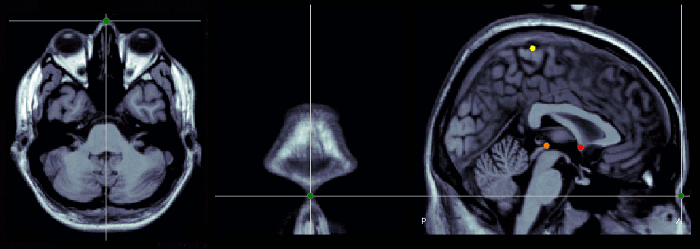
Pre-auricular points (LPA, RPA)
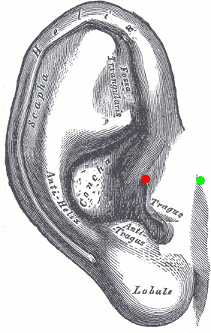
The proper definition of the preauricular point is: "a point of the posterior root of the zygomatic arch lying immediately in front of the upper end of the tragus". This is illustrated with the green point below. The problem with this definition is that it can be really difficult to localize precisely on the MRI. It can lead to severe misregistration between MRI and MEG/EEG. More information on the anatomical location of this point on the FieldTrip website.
Our proposition is to use instead the junction between the tragus and the helix, marked with a red dot in this figure. It can be located much more precisely both anatomically and on the MRI slices.
You can choose to use this definition of the "preauricular point" or not. The most important is to use the same convention for all the steps: digitization of head points (eg. Polhemus) and analysis with Brainstorm.
Use the sagittal orientation to define it.
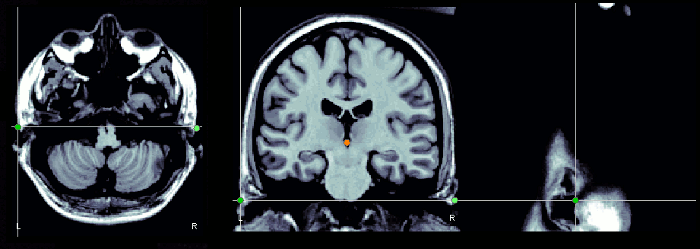
Notes for CTF users
Using a CTF system, you would probably prefer to use the head localization coils to indicate these NAS/LPA/RPA points, instead of these "anatomically correct" points. The coordinate system in the CTF files is based on the position of the three coils you stick on the head of the subject. Typically, the nose coil is slightly above the nasion, and the ear coils about one centimeter more frontal than the points that were previously described.
A good practice is to take pictures of the subject with the coils on, right before bringing him/her in the MEG, and digitize the position of the center of the coils as the nasion/LPA/RPA. Then, when importing the MRI in Brainstorm, try marking as accurately as possible the position of the coils in the MRI. You cannot be very precise at this point, but the errors here are fixed later with the automatic registration.
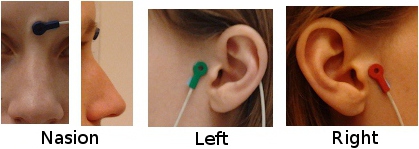
IMPORTANT: These comments do not apply if you use the Brainstorm Digitize program to drive the Polhemus device. In this case, you are asked to digitize two sets of NAS/LPA/RPA points: the coils and the real anatomical points. Just make a copy of the .pos file saved by Digitize in the .ds folder, then set the real anatomical points in the MRI. Brainstorm is going to automatically handle the transformation between the CTF coils coordinate system and the real subject coordinate system. The result is usually much more accurate and does not require to take pictures of the subjects.
Using a default anatomy
The fiducial points (Nasion, LPA, RPA) used in your recordings might not be the same as the ones used in the anatomy templates in Brainstorm (Colin27, ICBM152, FSAverage). By default, the LPA/RPA points are defined at the junction between the tragus and the helix, as represented with the red dot.
If you want to use an anatomy template but you are using a different convention when digitizing the position of these points, you have to modify the default positions of the template with the MRI Viewer.
- Go to the anatomy view
In (default anatomy), right-click on the MRI > Edit MRI
- Modify the position of the fiducial points to match your own convention
- Click on [Save], it will update the surfaces to match the new coordinate system
MRI coordinates
Coordinates system used to index voxels in the space of the MRI volume, in millimeters:
Axis X: left>right
Axis Y: posterior>anterior
Axis Z: bottom>top
- The first voxel at the bottom-left-posterior of the MRI volume is voxel (1,1,1). The coordinates of the center of this voxel in millimeters is (voxelsize_x, voxelsize_y, voxelsize_z).
World coordinates
Coordinates system used in the original MRI file, that was loaded as the reference MRI for a subject. It is defined by a 4x4 matrix saved directly in the MRI file. From NIfTI .nii files, it uses the matrix sform if available, or otherwise the matrix qform (see the NIfTI documentation). From FreeSurfer .mgh/.mgz files, it uses the vox2ras matrix (see the FreeSurfer documentation).
In practical terms, it corresponds to the coordinates you see in the title bar when loading your volume in MRIcron. The coordinates you see in the text boxes correspond in Brainstorm vocabulary to "voxel coordinates".
MNI coordinates
Two types of normalized coordinates are widely used in the literature: the atlas defined by Jean Talairach, and the MNI stereotaxic coordinates. You can read about the differences between these two systems on that page: http://imaging.mrc-cbu.cam.ac.uk/imaging/MniTalairach
Two of the templates distributed with Brainstorm (Colin27 and ICBM152) are registered in the MNI stereotaxic space, therefore the "MNI coordinates" can be derived easily from the MRI voxel coordinates. For these two brains, you can read the normalized MNI coordinates directly in the interface ("MRI Viewer" or "Get coordinates" menu). The values should be almost identical to what you get when opening these volumes with the "Display" program from the MINC tools.
To be able to get "MNI coordinates" for individual brains, an extra step of normalization is required.
The method we use in Brainstorm is based on an affine co-registration with the MNI ICBM152 template from the SPM software. This function directly uses code from SPM12 (spm_maff8 ©J Ashburner), described in the following article: Ashburner J, Friston KJ, Unified segmentation, NeuroImage 2005
To compute the linear transformation matrix between the individual MRI and the ICBM152 template:
- In the MRI Viewer: Click on the link "Click here to compute MNI transformation".
In the database explorer: Right-click on the MRI > Compute MNI transformation.
Talairach coordinates
If we cannot compute the MNI transformation as presented in the previous section, we use an approximation to the Talaraich coordinate system. It relies on two points, the posterior and anterior commissure, and the midsagittal plane. The third point needed here, the interhemispheric point, is used to define this plane. You can read about the differences between these two systems on that page:
Anterior commissure (AC)
Description of the anterior commissure at this Wikipedia page.
Technique to localize it:
- Use the axial orientation.
- Start from a slice just below the corpus callosum and move around it (slightly up or down)
- You are looking for a small fiber tract that connects the two hemispheres
- You should find two spots corresponding to this description. The more frontal one is the anterior commissure, the other one is the posterior commissure
- Once you have localized it: if it is visible on more than one slice, use the upper one (the one closest to the top of the head).
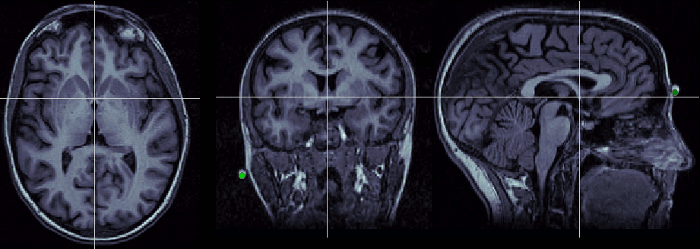
Posterior commissure (PC)
Description of the posterior commissure at this Wikipedia page.
Technique to localize it:
- Use the axial orientation
- It is a fiber tract similar to the anterior commissure, but a few centimeters more posterior.
- If it is visible on more than one slice, pick the lowest one.
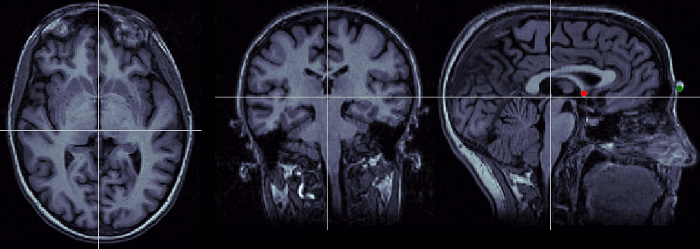
Interhemispheric point (IH)
Pick any point in the interhemispheric space, somewhere in the top of the head. Do not use a point too close from the commissures.
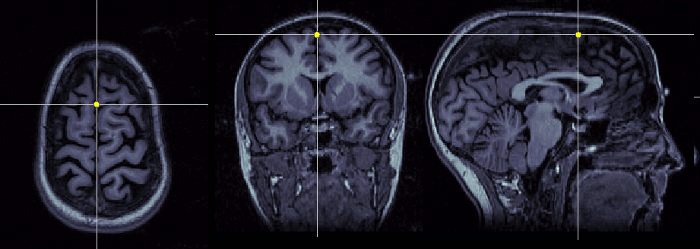
Neuromag coordinates
This coordinates system is not used in Brainstorm, and described here only FYI. All the information contained in Neuromag .FIF files are in this CS, and converted to Brainstorm SCS at importation.
It is defined in the following way:
Based on: Nasion, left pre-auricular point (LPA), and right pre-auricular point (RPA).
Origin: Intersection of the line L through LPA and RPA and a plane orthogonal to L and passing through the nasion.
Axis X: From the origin towards the RPA point (exactly through)
Axis Y: From the origin towards the nasion (exactly through)
Axiz Z: From the origin towards the top of the head
Converting between coordinate systems
The conversions between coordinate systems is handled with one single function cs_convert:
sMri: MRI structure from the database: right-click on the MRI file > File > Export to Matlab > sMri
- src/dest: Source and destination coordinates systems: {'voxel', 'mri', 'scs', 'mni', 'world'}
- P: List of points [Npoints x 3]
All the the coordinates have to be in meters (not millimeters).
Pdest = cs_convert(sMri, 'src', 'dest', Psrc);
Examples:
P_mri = cs_convert(sMri, 'voxel', 'mri', P_voxel); % Voxel => MRI coordinates P_mni = cs_convert(sMri, 'scs', 'mni', P_scs); % SCS => MNI coordinates
Brainstorm .pos files
The .pos files generated with the Brainstorm Digitizer contain both the positions of the anatomical landmarks (nasion, left ear, right ear) and the position of the head localization coils (HPI).
Having the two sets of points allows us to convert automatically from the native CTF coordinates (based on the coils) to the recommended landmarks in Brainstorm (based on the anatomical landmarks). When a Brainstorm .pos file is present in the CTF .ds folder, it is loaded automatically and used to convert the positions of the EEG and MEG sensors to the anatomical reference. This is done automatically without any message or user confirmation. In this case, you should mark the anatomical landmarks (real nasion and tragus/helix junctions) in the MRI Viewer when importing the anatomy. This is what is described in the introduction tutorials.
Otherwise, if you are importing CTF recordings without a Brainstorm .pos file in the .ds folders, or if you are importing the .pos files after linking the recordings to the database, you should typically select the positions of the CTF HPI coils in the MRI viewer.
The syntax of these .pos files is the following, one line per digitized point:
Number of EEG electrodes Index Label X Y Z : Defines an EEG electrode Index X Y Z : Defines a head shape point Label X Y Z : Defines a reference point
In the .pos files, the anatomical landmarks are labelled Nasion/LPA/RPA, and the CTF HPI coils are labelled HPI-N/HPI-L/HPI-R (for nasion coil, left coil, right coil). Note that in the CTF software, the HPI coils are labelled NAS/LPA/RPA, which can lead to some confusion.
We usually take multiple measures of each reference point and average them when we load the file. This helps improving the accuracy of the registration.
2 1 Cz 5.29886357 -0.39211620 13.97175211 2 Pz -2.72999896 0.56457819 14.80592908 3 9.47286768 0.09984190 -2.22056385 4 9.61745050 -0.00705346 -2.64471836 [...] 242 2.68917264 3.02778502 13.88281027 243 1.10525214 3.54043941 14.17347208 Nasion 9.59228188 0.08328658 -1.88504105 LPA -0.47469294 6.81987024 0.62870235 RPA -0.96029260 -6.72333418 0.16475241 Nasion 9.76823213 -0.11917776 -1.87417223 LPA -0.29274026 6.88415084 0.70120923 RPA -0.99183277 -6.70128616 0.08443862 HPI-N 10.61990713 0.01532629 0.00407281 HPI-L 0.20165313 6.74350937 -0.00134360 HPI-R -0.23124566 -6.76723759 -0.00008921 HPI-N 10.61095674 -0.01532629 -0.00407281 HPI-L 0.27017080 6.81335558 0.00134360 HPI-R -0.24057827 -6.78962736 0.00008921
Additional documentation
Tutorial: Channel file / MRI registration
Forum: Bad MEG-MRI registration
Forum: Coregistration validation
Forum: Import the position of SEEG/ECOG contacts: Post #2206, Post #1958, Post #2357
